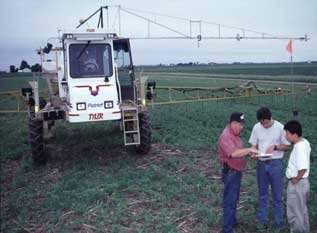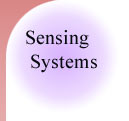Variable Rate Technology
Our goals for a research program in agricultural chemical application systems are to provide better knowledge on, and
develop better control devices for field chemical applications. The research scope includes the properties and behaviors
 of spraying nozzles, field and laboratory test measurement and computer modeling of spraying systems, and alternative
chemical application technologies.
of spraying nozzles, field and laboratory test measurement and computer modeling of spraying systems, and alternative
chemical application technologies.
United States farmers apply more than one billion pounds of pesticides annually, representing a significant portion of the variable costs of agricultural production. At numerous sites, concentrations of these herbicides in ground and surface water have exceeded federal health levels. Herbicides such as atrazine and alachlor are potential threats to the safety of drinking water supplies. Public concerns about health risks associated with herbicide residues have increased as more cases of herbicide-contaminated water supplies have been reported.
With the support from both government agencies and the private sector, we have been developing the next generation of chemical application systems for major crop production.
Nozzle fluid dynamics simulation
Many new spray nozzles for agricultural chemical applications have been introduced in recent years. In the air-induction or air-inlet design of these commercially available nozzles, little is known about the dynamics of air interspersing into the liquid stream. Two-phase computational fluid dynamics (CFD) models have provided insight to the actual fluid phase interactions and associated flow characteristics, such as turbulence, affecting droplet size. The project has obtained support from the National Computational Science Alliance based at the University of Illinois utilizing the NCSA SGI/CRAY Origin 2000 supercomputer.
Variable rate nozzle
We also work in the area of practical spraying systems and variable rate nozzle performance studies. We have studied the modulated spraying nozzle control (MSNC) system products intensively. The MSNC can be used to adjust chemical application rates without changing droplet size or the spray pattern across the boom. We conducted laboratory experiments to determine the spray pattern of an MSNC system along the sprayer travel direction under different travel speeds. A discrete accumulate method was developed to determine both the spatial and temporal spray patterns for the entire spraying area. To apply the MSNC system, we developed a single nozzle variable-rate controller for individual nozzle control on the spray boom. The spray controller could be used on existing sprayers for maintaining the application rate as the speed changes by controlling the flow rate. For local sensor-based site-specific herbicide application, the controller can adjust the dosage of each individual nozzle control area in real-time. Because of the potential of this technology, an equipment manufacturer has already included our controlling system design in their new product development plan.
Smart sprayer
We have developed the technology of a site-specific herbicide application system (smart sprayer). This research integrated a real-time machine vision sensing system with an automatic herbicide sprayer to create an intelligent sensing and spraying system. To increase the herbicide delivery accuracy, each spray nozzle was controlled separately. The integrated system was tested to evaluate its effectiveness and performance under varying field conditions. With the current system design and using 0.5% weed infestation as the control zone threshold, herbicide savings of 48% could be realized. One of our peer reviewed journal papers entitled "Development of a precision sprayer for site-specific weed management" won the highest honor paper award from the American Society of Agricultural Engineers - The ASAE Superior Paper Award.
Our future goals in this research area are two fold: first, we plan to collaborate with crop scientists and optimize the real-time sensing/control system and develop new high accuracy selective weed control strategies. Secondly, we plan to push the capitalization on the new "smart sprayer" technology. The development of a low-cost and robust sensing and controlling system is one of our major targets. The equipment industry is now technologically ready for the next generation of precision weed control systems. An objective and quantitative field performance evaluation would help to prove the economics and practicality of the technology.
Movies
 MPEG Format (8Mb) |  Real Meadia Format (4Mb) |  Real Meadia Format (0.5Mb) |




